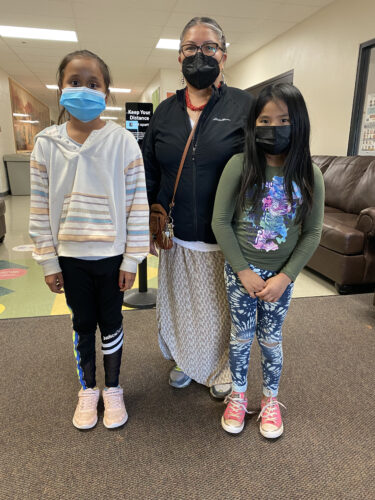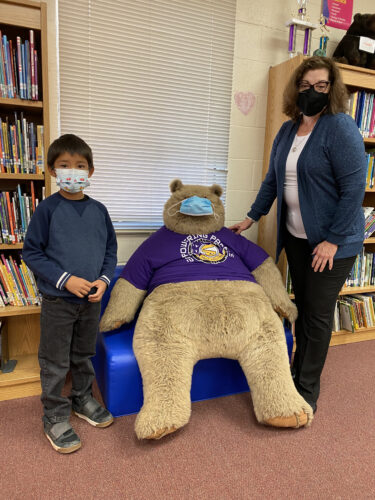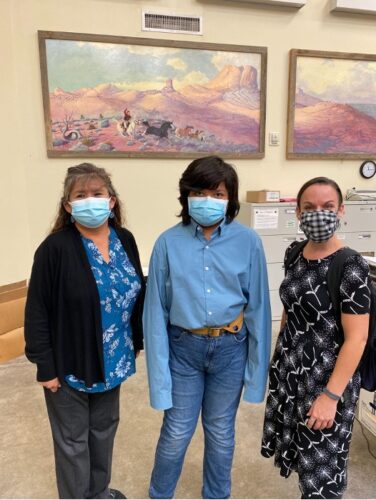Our volunteer coordinators are the backbone of our organization, and we couldn’t do our work without them. Today we hear from our Director of U.S. Programs, Renée Kube, as she visits with Lucy at Dennehotso Boarding School in Arizona, who works hard to ensure children in our program are getting everything they need all year long.
Meeting with Lucy
“Dennehotso is a small community about 27 miles northeast of Kayenta, Arizona. It is close to the intersection of U.S. Hwy 160 (an east-west route) and U.S. Hwy 191 (a north-south route),” said Renée.
“Lucy said our organization is so important to the school, and they are grateful for our long-standing partnership,” said Renée.
“Upon my visit, I was greeted by our very long-serving volunteer coordinator, Lucy. Lucy showed me around the school grounds, and as we walked, she shared how things have been going for her at the school.”
“Lucy explained that the school has capacity for 150 students, but at present just 113 are enrolled. The dorm was closed in March 2020 due to the pandemic and has still not reopened. Lucy said families have reached out to the school administration and expressed their desire for the dorm reopening, but the administration is still not ready. The administration and board are concerned about the children living in such close proximity, but another big stumbling block is that they are currently very short staffed,” said Renée.
“The children here are really struggling academically, largely due to disruptions associated with the pandemic. Many have witnessed the serious illnesses or even deaths of family members. During the school years of virtual instruction, many lost ground in their studies. At present, the average math and reading proficiency rates are just 10%-14% (depending on the grade), which is lower than the Arizona state average of 45%.”
An important partnership
“Lucy said that since the pandemic started, she has been given extra duties around the school in addition to her full-time job as Parent/Family Liaison. Her regular job involves gaining more involvement from parents and guardians in the children’s education; working with them in identifying and achieving various goals for their students (e.g. attendance); accessing support services (e.g. speech); administering programs to bridge the gap between home and school; and assessing students’ needs in order to implement plans to remove barriers to the students’ academic success and overall well-being. The latter two duties are where Children Incorporated’s sponsorship program fits in. Lucy said our organization is so important to the school, and they are grateful for our long-standing partnership,” said Renée.

Lucy, our volunteer coordinator, is pictured with two of our sponsored children.
“Lucy explained to me that being able to buy appropriate clothing for rapidly growing children is a blessing, all thanks to our sponsors. The children are excited, and the parents are incredibly grateful. Lucy said that she will usually drive out of state and shop in Farmington, New Mexico. This is 100 miles east, or a 200 mile round trip. However, she’s thinking of broadening her options and may start shopping in Cortez, New Mexico as well which is 92 miles one way, but has both a Walmart Supercenter and a Hibbets Sports Shop that sells athletic shoes.”
Hope In Action Helping those in need
“Lucy said she uses the sponsorship program funds for ‘tops and bottoms,’ because that’s what the parents and children request most. Whenever she can, she will supplement with additional gifts to buy shoes, which are expensive. Lucy said she would love to have extra funds for shoes, and she needs funds to supply a clothes closet for accidents, containing underwear, socks, pants, and tees. She would also like to have funds in the springtime for lice medicine, and I let her know I would be working to get those requests fulfilled through our Hope In Action Program,” said Renée.
“Despite the staff shortage that’s creating an extra workload, Lucy is striving to do her best for the Children Incorporated sponsored children. Overall, she is doing well in challenging circumstances, and we are equally as proud to work with Dennehotso Boarding School as they are to work with us.”
***
How do I sponsor a child with Children Incorporated?
You can sponsor a child in one of three ways: call our office at 1-800-538-5381 and speak with one of our staff members; email us at sponsorship@children-inc.org; or go online to our sponsorship portal, create an account, and search for a child that is available for sponsorship.



